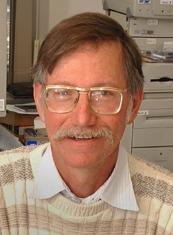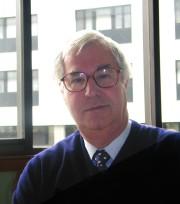2003 Haagen-Smit Prize Winners
The committee for the selection of the Haagen-Smit Award, given annually to two outstanding papers published in Atmospheric Environment (AE), has considered all nominations and made their final determination. We are very pleased to announce that the winners of the AE 2003 Haagen-Smit Award are:
Schwartz, S. E. and J. E. Freiberg, Mass-transport limitation to the rate of reaction of gases in liquid droplets, Atmospheric Environment, 15, 1129-1144, 1981.
Penkett, S. A., B. M. Jones, K. A. Brice, and A. E. Eggleton, The importance of atmospheric ozone and hydrogen peroxide in oxidizing sulfur dioxide in cloud and rain water,Atmospheric Environment, 13, 123-137, 1979.
With this announcement we would like to congratulate the authors and the nominators of these selected papers. These are indeed contributions that we can all be proud of. We would also very much like to thank all the other nominators for their effort and note that unsuccessful nominations are eligible for consideration again next year.
We further take this opportunity to acknowledge the hard work of the selection committee, made up of members from six countries, in arriving at a clear and timely decision.
Sincerely,
Hanwant B. Singh and Peter Brimblecombe
Executive Editors of Atmospheric Environment
Jacques Kiebert
Senior Publishing Editor, Elsevier Science Limited
Nomination Letters*
 Schwartz, S. E. and J. E. Freiberg, Mass-transport limitation to the rate of reaction of gases in liquid droplets, Atmospheric Environment, 15, 1129-1144, 1981.
Schwartz, S. E. and J. E. Freiberg, Mass-transport limitation to the rate of reaction of gases in liquid droplets, Atmospheric Environment, 15, 1129-1144, 1981.
At its time of publication this article was by far the most thorough and accurate formulation and discussion of the physical and chemical mechanisms governing the interaction of trace gaseous species with atmospheric droplets. It quantified the appropriate time scales and rates of gas phase transport, mass accommodation, dissolution, and liquid phase reaction over the parameter ranges of interest for atmospheric chemistry. It also established criteria for steady state approximations of key concentration distributions that allow model simplifications.
Although formulated in the context of SO2 oxidation in cloud droplets, a topic of central interest to the contemporary acid rain issue, the basic formulation can and has also be used to analyze a wide range of heterogeneous atmospheric processes, including: reservoir gas halogen activation and nitrogen oxide sequestration in stratospheric aerosol particles, a critical processes in stratospheric ozone depletion; tropospheric cloud processing of both nitrogen oxides produced by combustion and lightning and halocarbonyls from the photo-oxidation of hydrogen containing CFC replacement compounds; and the processing of sulfur and halogen compounds in sea salt aerosols.
Furthermore, as first illustrated in the Freiberg and Schwartz paper that immediately followed in the same issue of Atmospheric Environment, the same formalism is extremely useful in analyzing laboratory experiments purporting to measure specific interfacial and bulk rate parameters for heterogeneous processes. Today variations of the Schwartz and Freiberg formulation are used by essentially all the leading gas/aerosol laboratory kinetics groups to analyze their experimental data. The paper itself has been cited over 140 times.
The holistic approach to trace gas interactions with atmospheric droplets/particles pioneered in the Schwartz and Freiberg paper was later codified in the resistor model of trace gas uptake which is not only widely used for both atmospheric model and laboratory data analyses, but is presented in leading atmospheric chemistry textbooks (e.g. pp. 159-163 of Chemistry of the Upper and Lower Atmosphere by B.J. Finlayson-Pitts and J.N. Pitts, Jr., Academic Press, 2000).
In summary, the Schwartz and Freiberg paper is clearly a key founding document of modern atmospheric heterogeneous chemistry and is well worthy of the Haagen-Smit Prize, named for one of the key founders of atmospheric chemistry.
Nominator: Charles E. Kolb, Aerodyne Research, Inc., Massachusetts, USA
 Penkett, S. A., B. M. Jones, K. A. Brice, and A. E. Eggleton, The importance of atmospheric ozone and hydrogen peroxide in oxidizing sulfur dioxide in cloud and rain water, Atmospheric Environment, 13, 123-137, 1979.
Penkett, S. A., B. M. Jones, K. A. Brice, and A. E. Eggleton, The importance of atmospheric ozone and hydrogen peroxide in oxidizing sulfur dioxide in cloud and rain water, Atmospheric Environment, 13, 123-137, 1979.
This is one of the most celebrated papers published in Atmospheric Environment. With a record of over 370 citations, it is also one of the most frequently cited in atmospheric sciences. This paper was responsible for a major breakthrough in the understanding of the chemistry of rainwater and of aspects of the sulfur chemistry of the atmosphere which had been studied throughout the 19th and 20th centuries. It clearly showed for the first time that the most efficient oxidation process for sulfur dioxide (SO2) in cloud droplets was reaction with the strong oxidants ozone and hydrogen peroxide, and that by comparison, reaction with oxygen in the droplets was of little or no importance.
The Penkett et al. paper gave accurate rate data and showed that the ozone reaction predominated above pH 5.8; at pHs below this, which is typical for most cloud water in the atmosphere, the hydrogen peroxide reaction dominates, mainly due to its positive catalysis by protons. It pointed out that the peroxide reaction was the only one of all SO2 oxidation reaction studied which was catalyzed by protons, making it very efficient in creating acidity in rain. The paper further demonstrated that most of the reaction would take place in cloud rather than rain droplets because of their differing sizes, and that the peroxide reaction in its own right was capable of producing all of the sulfate content in the rain within minutes, provided sufficient hydrogen peroxide was available in the gas phase. This was a very significant result. Interestingly, the paper linked an old feature of the chemistry of rainwater, which had been known for decades, with a new feature of the chemistry of the troposphere; namely that extensive free radical chemistry was capable of producing peroxides on a wide scale. The peroxide concentration used in the calculations (1 ppbv) came directly from Levy and Crutzen's pioneering work on tropospheric chemistry in the early 1970's.
The 1979 publication was the culmination of some extensive studies at Harwell in the 1970's of the atmospheric chemistry of SO2 both in the gas phase and in aqueous solution. Several papers were published by Penkett and co-workers on the photochemical oxidation of SO2 in sunlight, on its oxidation by-products of the ozone-olefin reaction, and on its oxidation in solution by oxygen, ozone and hydrogen peroxide. A companion paper, concerned with the influence of metal catalysts on the efficiency of the oxygen reaction in solution, was also published in the same volume of Atmospheric Environment in 1979. Taken together, this work clearly showed that SO2 was efficiently oxidized by a multi-phase process involving oxidants produced by free radical chemistry. It thus preceded the work on multi-phase chemistry linked to the rapid destruction of ozone in the polar stratosphere. These two examples of multi-phase chemistry indicate how efficient it can be in certain conditions, particularly when the purely gas phase processes are inefficient. Many aspects of the work were subsequently repeated by others and the paper led directly to major campaigns concerned with measurements of peroxides in the atmosphere and their influence on SO2 oxidation and on confirming aspects of the theory of tropospheric chemistry.
The work has certainly stood the test of time. It is now well known that about 80% of all sulfate in the atmosphere is produced by oxidation of SO2 by ozone and peroxide in droplets. This is shown to good effect in a January 2003 publication in the Journal of Geophysical Research jointly by the Seinfeld and Jacob groups. They show that gas phase oxidation of SO2 by hydroxyl radicals produces less than 20% of the sulfate whereas droplet oxidation produces over 80%, one quarter by reaction with ozone and three-quarters by reaction with peroxides. As pointed out in the original 1979 paper, these processes produce a large part of the acidity in rain water and contribute a large fraction of the sulfate aerosol. The paper thus made a major contribution to the understanding of pollution in the form of acid rain and poor visibility. It has often been used in major reviews such as those by the National Academy of Sciences on Acid Precipitation in North America, and on Global Tropospheric Chemistry. It has become absorbed into the basic understanding of the chemistry of the troposphere and is extensively used in textbooks concerned with atmospheric chemistry theory. Two decades later this paper continues to be cited, more so nowadays because of its relevance to the background sulfate aerosol and its impact on climate. The work in fact is one of the pillars on which the whole subject is based.
Prof. Penkett and his group are highly regarded for their innovative and extensive contributions to studies of air pollution and atmospheric chemistry. Their pioneering efforts have brought credit to the journal, and I believe that the subject paper is a highly worthy recipient of the 2003 Haagen-Smit Award.
Nominator: Dr. Hanwant B. Singh, NASA Ames Research Center, California, USA
*-picture of first author shown
